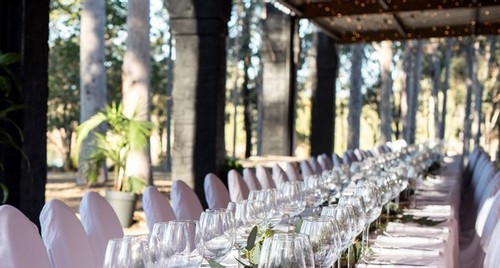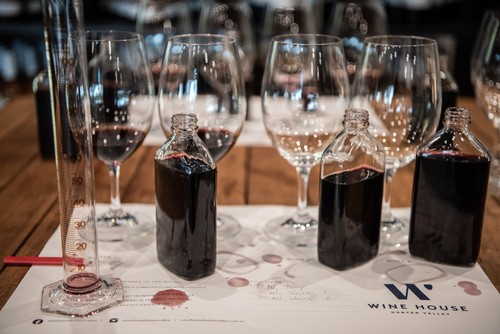Hunter Valley Harvest
The growing season for the 2025 vintage started with budburst back way back in August last year so it’s a long haul for vineyard managers to get the vineyards to the point where they are ready to harvest. There are certainly no long summer holidays for them (or short ones) and with a hot spell over the Christmas/New Year period, many growers were constantly working to keep the water up to the vines. With some cooler temperatures and a bit of mid-January rain the vines were looking stress free and ready to do the last push of ripening. Then the Hunter does what it loves to do ... it rained. This stalled most vineyards for a week or so but the clouds parted and it was game on for the white varieties.
A key feature of this season was some cooler overnight temperatures early in the season which is ideal for acid retention and slightly extends the growing season which is perfect for flavour development. Crops were also well up on previous years, especially Semillon. Reds are now all harvested with the lower yielding vineyards coming in at some pretty impressive ripeness levels. All up it was a vintage with a bit of everything thrown in – hot, cold, wet, dry - you name it. Keep an eye out for some sensational 2025 whites and seek out the reds from old-vine vineyards.
2024 Wrapped at Our House
As the year comes to a close, we’ve taken a moment to reflect on 2024 and celebrate our top five House Highlights – the moments that truly defined this year!
1. Liz Silkman - Halliday Winemaker of the Year 2025. Pretty hard to top that! As the first Hunter Valley winemaker to win this award, it was not only deserving recognition for Liz' incredible talent but it made the entire Hunter Valley very proud.
2. New Winemakers in the House. This year we have welcomed so many new Housemates including our Young Guns, Charteris Wines and most recently Riggs & Wiggs. This label is the new folly of Iain Riggs and his mate Peter Wiggs. Iain was Chief Winemaker of Brokenwood for over 35 years and quite the Hunter Valley legend. We're excited to showcase his new wines.
4. France fought the Hunter, and the Hunter won! In July we hosted a fabulous long lunch with a showdown of Chardonnay and Shiraz from France and the Hunter. General consensus was that the Hunter beat the Frogs (definitely no bias in the room😉).
3. Another successful year of fundraising. We only do one sale a year and our Wishing for Wine Charity Wine Sale every June is always a big one. So far we have raised over $185,000 for charity and here's what our chosen charity, The Smith Family had to say: Wine House Hunter Valley’s support can provide practical, emotional, and financial support that empowers young people to harness education and to build skills to unlock their true capability.
5. New neighbours! In July, Meerea Park moved in right next door. Established in 1991, Garth and his team are just a short stroll (about 10 metres) from our tasting bar so be sure to leave time to visit Meerea Park when you next visit us.
Every wine in our collection is crafted by a family who owns and operates their business. No intermediaries, no shortcuts. This unwavering commitment to authenticity is what makes our wines truly exceptional.
We wish you all a wonderful Christmas 🎄and a Happy New Year 🥂🍾
Cheers, from all of us at Wine House Hunter Valley 😊
YOUNG GUNS IN THE HOUSE
This October Long Weekend, we'll be shining the spotlight on some of the Hunter's most exciting new talent! The Wine House has a long history of being a 'hothouse' for emerging young wine brands and this weekend will be all about Hunter wines, re-imagined!
🍇 What’s in Store?
Book your Young Gun Tasting and unearth the next generation's twist on tradition, crafting bold and exciting wines that are ripe for discovery! Plus, some of these rising stars will be making special guest appearances throughout the weekend, sharing their stories and passion with you!
🌿 Featured Wineries:
Thea Wines
Aeon Wines
Sabi Wabi
Glover Wines
Gunpowder Wines
Pokolbin Vintners
📅 The Details:
Young Gun Tasting available all weekend $15pp (free for Members + 1 guest)
On Saturday, we'll also have live music + delicious bites from our food truck 3 - 6pm 🍔🎶
Liz Silkman WINS Winemaker of the Year!
We're raising a glass (of Silkman, of course!) to celebrate an incredible achievement from one of our very own! Liz Silkman, the mastermind behind Silkman Wines, has just been awarded the prestigious title of Winemaker of the Year in the 2025 Halliday Wine Companion Awards!
This is a tremendous honour, not just for Liz Silkman, but for the entire Hunter Valley wine region. This extraordinary feat is a resounding endorsement of the Hunter Valley's exceptional winemaking prowess and the unwavering dedication of its family-owned, independent producers. Liz's achievement places the Hunter Valley firmly on the national stage as a premier wine region.
Liz's journey in the world of wine is truly inspiring. Together with Shaun, they've built Silkman Wines into a powerhouse producer of exceptional Semillon, Chardonnay, and Shiraz.
This award is a testament to Liz's unwavering commitment to quality, meticulous attention to detail, and a deep respect for the Hunter Valley's unique terroir.
We have a great range of Silkman wines on tasting every day, book your tasting and explore Liz' exquisite wines.
Vintage 2024
Another year in the barrel, and what an interesting vintage it has been!
The lead up to 2024 vintage was warm and dry, and these conditions resulted in the formation of small berries and bunches. A wet and cool December turned into a dry and warm January, and this, combined with the small berries, resulted in super-fast ripening fruit. We had ripe sugar and flavours very early, resulting in us beginning our harvest on January 8th which was one of the earliest ever start dates in Margan’s nearly 30-year history.
In 2023 vintage we hadn’t even started picking Semillon until February. This year, by February, we had finished picking Semillon and were already well into picking the reds. As you can see, viticulture and winemaking are a very unpredictable business.
As mentioned, these weather conditions resulted in noticeably smaller berries. The benefit of this is that you gain wonderful concentration of fruit and flavour. For example, our white wines from this vintage are already exhibiting great flavour and texture. The reds from this vintage are now in oak and early signs show rich, powerful wines across all varieties. Keep your eye out for these as they move from the barrel to bottle.

The Rise and Splendour of Argentina's Wine scene
|
When it comes to world-renowned wine regions, Argentina might not be the first country that comes to mind. However, in recent decades Argentina has emerged as a force to be reckoned with in the global wine industry. With its breathtaking vineyard landscapes, commitment to quality winemaking, and unique grape varieties, Argentina has captivated wine enthusiasts around the world. In this blog, we embark on a journey to explore the rise and splendour of Argentina’s wine industry, uncovering its history, signature grape varieties, key regions, and noteworthy achievements. |
 |
|
A Historical Glimpse: Argentina’s winemaking tradition dates back to the early Spanish colonisation in the 16th century. However, it was in the mid 19th century that the modern wine industry began to take shape. Influenced by European immigrants, particularly from Italy and Spain, Argentina embraced their winemaking techniques, vineyard management practices, and grape varieties. Over time, the industry experienced significant growth, transforming Argentina into one of the world’s largest wine producers. |
|
Signature Grape Varieties: Malbec stands as the undisputed king of Argentina’s wine production. Originally from France, Malbec found its ideal terroir in high-altitude vineyards of Mendoza, Argentina’s most prominent wine region. Argentine Malbec is known for its intense purple colour, rich flavours of blackberries, plums and dark chocolate, and velvety tannins. Other red grape varieties like Cabernet Sauvignon, Syrah, and Bonarda also thrive in Argentina’s diverse terroir, offering complex and captivating wines. |
|
Key Wine Regions: Mendoza, nestled in the foothills of the Andes Mountains, steals the spotlight as Argentina’s premier wine region. With its high altitude, arid climate, and alluvial soils, Mendoza provides the perfect conditions for grape cultivation. Within Mendoza, sub-regions like Luján de Cuvo and Valle de Uco produce some of the finest wines in Argentina. Luján De Cuvo is renowned for its robust Malbecs, while Valle de Uco showases elegant, cool-climate wines. Salta is another notable wine region in Argentina known for its high-altitude vineyards and its delicate, aromatic white wine made from Torrontés. |
|
Winemaking Techniques and Terroir: Argentina’s winemakers have embraced modern winemaking techniques while preserving traditional craftsmanship. They utilise start-of-the-art technology to ensure the highest quality wines, while also respecting the unique characteristics of their terroir. The combination of high-altitude vineyards, ample sunshine, low rainfall, and diverse soils allows winemakers to produce wines with excellent balance, vibrant acidity, and expressive fruit flavours. |
|
Achievements and Global Recognition: In recent years, Argentina’s wines have garnered significant acclaim and recognition on the international stage. Argentine wineries have received prestigious awards and high scores from renowned wine critics, further solidifying the country’s position in the global wine industry. Additionally, the wine tourism industry in Argentina has experienced remarkable growth, with visitors flocking to the breathtaking vineyard landscapes, enjoying cellar tours, and indulging in wine tastings. |
|
The wine industry in Argentina has evolved into a captivating tale of passion, innovation, and dedication to quality. From its humble beginnings to its current global recognition, Argentina’s winemakers have transformed the country into a true wine destination. Whether it’s the seductive allure of Malbec or the elegant expressions of other grape varieties, Argentina’s wines offer a unique sensory experience that reflects the country’s rich heritage and remarkable terroir. So, the next time you sip a glass of Argentine wine, raise a toast to the land of gauchos and tango, where the vines thrive and flavours flourish. |
|
We will be hosting an Argentinian style lunch at the Wine House on the 21st October 2023! Join us by booking your seat at the table where we will be showcasing Argentinian wines alongside their Hunter Valley equivalents while we dream of travels to this magical country. |
Five great Christmas Party ideas at our House
|
Now is a great time to begin organising and securing your preferred date for your Christmas Party! To help ignite your holiday cheer, we have curated 5 exceptional Christmas party ideas that will make your end of year celebration memorable. We partner with some of the best businesses in the Hunter Valley and can help with any transport and accommodation needs. Contact our events team to get the ball rolling on your best Christmas Party ever! |
 |
|
1. Long Lunch on our Terrace
|
 |
|
2. Themed Cocktail Party Our Cocktail Party package is great way for you and your team to mix and mingle. Enjoy a night of roaming canapes, flowing wine, and laidback conversations. You can also add a DJ or some live music to bring the party alive. Why not make it themed to help break the ice and bring colleagues closer as friends. Some of our popular Christmas themes are Masquerade or White Christmas.
|
 |
|
3. Team Building Wine Blending Class with a Winemaker This is a fun and casual way to provide an interactive Christmas Party idea. Be a winemaker for the day and try your hand at making your very own red wine blend. Our winemaker will guide your team through the process and once you have made your award-winning blend you can label up a sample bottle to take home with you!
|
|
|
|
4. Decadent Dinner with Live Music or a DJ This is the ultimate package for those who like to party. Start your night with a welcoming glass of sparkling, then indulge in a festive 3-course dinner and beverage package. Then you can dance the night away with a live DJ or band. This will be a night to remember with five hours of fun, food and dancing.
|
 |
|
5.Ultimate Hunter Valley Christmas For the ultimate Hunter Valley Christmas Party, we can help arrange for Hot Air Balloon rides, Helicopter flights as well as VIP Tours. We can work with you to design your dream team getaway.
|
Pinot Gris, Pinot Grigio, same same or different?
Firstly, let’s clear one thing up: Pinot Gris and Pinot Grigio are made from the same grape variety.
So why the different names? The French call it Pinot Gris (gris is French for grey) and the Italians call it Pinot Grigio (you guessed it, Italian for grey). In Australia there was a push to simply call it Pinot G but not surprisingly, it didn’t really catch on (G having all sorts of connotations which we don’t need to explore here). But Pinot G is a less confusing term when talking about the variety itself so we’ll use it here, for educational purposes only.
Pinot G is a mutation of the red grape variety Pinot Noir and is quite a dark skinned grape. When fully ripe the bunches could even be mistaken for a red grape and the resulting juice has a greyish colour, hence the name. Pinot G originated in France's Burgundy region then travelled abroad to many countries, most notably Italy where they really put their stamp on it. Not only did they change the name and the style of the wine but they embraced it as their main white grape variety. To give you some idea of Italy’s dominance with this grape, Italy has 24,500 hectares under vine compared with France’s 2,800 hectares (Australia has 3,700 hectares). *
However, the difference between Pinot Gris and Pinot Grigio isn’t just how you say grey, they are stylistically quite different and can be traced to their traditional regions. Although originating in Burgundy, it is the Alsace region of France that is famous for their finely tuned and delicately aromatic Pinot Gris wines. Outside of France, you will generally see other cooler regions such as New Zealand, Tasmania and southern Victoria make theirs in a Gris style as a nod to the Alsace wines. Generally speaking, Pinot Gris wines are richer, fuller-bodied wines and can have noticeable sweetness. The wines are aromatic, fruity with a hint of spice and can have a slightly pinkish hue. They are usually in a tall, thin ‘hock’ bottle, this bottle is traditionally used for other aromatic whites such as Riesling and Gewurztraminer.
On the other hand, Pinot Grigio is a lighter-bodied wine with a crisp, refreshing taste. It is made in a dry style, with little to no residual sugar. Pinot Grigio is typically less aromatic than Pinot Gris and can be minerally, flinty and have a much lighter texture. They are usually packaged in a clear or green ‘claret’ bottle and they are great with seafood or anything oily that calls for a wine with crisp acidity to cut through the richness.
When it comes to Australian Pinot G there are no hard and fast rules as to what is labelled Pinot Gris or Pinot Grigio, and with every different region and every different year there can be variations in the style. So just use the label as a general guide; if you prefer an aromatic, delicate wine with perhaps a touch of sweetness, go for a Pinot Gris but if you prefer a crunchy crisp dry white – grab a Grigio!
*Statistica 2023
The Wonderful World of Wine Glasses
Wine glasses come in so many different shapes and sizes, each one claiming to enhance the unique characteristics of a specific type of wine. But do they really make a difference? Let’s have a look at how the shape and size of the glass can affect the way a wine smells, tastes and feels in your mouth.
Let’s start with a red wine glass. Have you ever ordered a red wine in a restaurant only to have the waiter whisk away the wine glasses that were sitting ready on your table? This can be a little disconcerting until they return to the table armed with larger, altogether more beautiful wine glasses to serve your wine in. The reason a red wine glass typically has a larger bowl than a white wine glass is because red wine is served at a higher temperature than white wine and the larger bowl allows more room for the wine to breathe and release its complex aromas. Additionally, the bowl of a red wine glass is often tapered at the top, which concentrates the aromas of the wine, making it easier to detect the different scents of the wine (and less easy to cover yourself in red wine as you expertly swirl your glass).
White wine glasses on the other hand, tend to have a smaller bowl and a narrower opening than red wine glasses. This is because white wine is typically served chilled and the smaller bowl keeps the wine cool for a longer period of time. Additionally, the narrow opening of the glass helps to preserve the delicate aromas of the wine, which can be easily lost if the wine is exposed to too much air.
Champagne glasses, also known as flutes, have a tall, slender bowl and a narrow opening, which helps to preserve the bubbles of the wine. The narrow opening helps to maintain the effervescence of the wine, and the tall bowl allows the bubbles to rise to the surface, creating a sparkling sensation on the tongue.
So whilst it may seem to be just another way to confound the average wine drinker, using different shaped glasses for each type of wine can really bring out the best in a wine. If nothing else, it’s a fun thing to try the same wine in a range of different wine glasses. You may be surprised, or not! In which case you can safely stick to your vegemite jars!
Vintage 2023
Vintage 2023 is getting underway around the Hunter Valley. Most wineries have started to bring in their Chardonnay and Verdelho crops with Semillon and the alternative varieties to follow. There's no rule saying white grapes have to be picked before reds and the prediction is that a lot of low yielding Shiraz vineyards and early ripening varieties such as Tempranillo will come in before some of the Semillon vineyards.
It hasn’t been an easy growing season but the hot, dry weather in late December through January has saved the day. Vintage is an exciting time in the Valley with the buzz of tractors, harvesters and wineries busy around the clock. The many months of hard work in the vineyard comes to fruition as the baton is passed from the viticulturists to the winemakers.
Stay tuned for a full round up of #v23 when it wraps up at the end of March !
